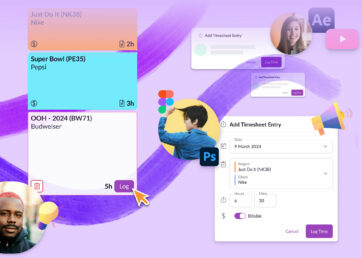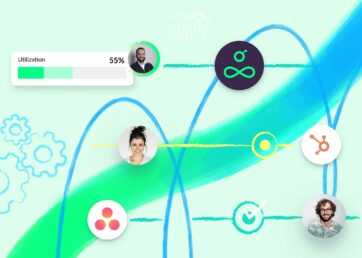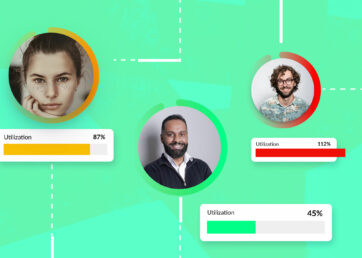Amirreza Farhadi is the Associate VP of Operations at Havas CX Canada. Part of Havas’s senior leadership team, he builds, monitors, and improves processes to ensure the business runs smoothly. In his eyes, that starts with taking care of the employees.
We spoke to him about how Havas CX Canada sets boundaries, puts employees first, and continues to pioneer work-life balance at ad agencies.
Havas CX Canada approaches employee well-being and work-life balance unlike any agency I’ve ever heard of. Because the truth is this: it’s challenging. And for agencies, perhaps even more so. There are deadlines to meet, clients to please, and work seems never-ending.
And Farhadi acknowledges that upfront.
“Finding a balance is always going to be tough for agencies, especially when we’re about to launch something and we have hard deadlines.”
So over the years, he’s finessed strategies and created processes that make sure employees’ health and work-life balance are protected in the long run.
Where does that start? It starts with the clients.
In this article 📖
Working 9-5 (for service and devotion)
Dolly Parton’s famous lyrics have probably escaped no one. But finding 9-5 in your client’s terms and conditions is probably a different story.
That’s right.
At Havas CX Canada, clients are informed about their team’s working hours upfront to make sure things don’t get out of hand.
Farhadi explains, “We have language in our contracts that communicates the typical working hours of our team. For example, this might say we’re available from 9 am to 5 pm Eastern time. It also states that we’re not available over the weekend, except for 24/7 types of contracts.”
This is a way for Havas CX Canada to set expectations with the clients from day one.
Farhadi knows that there’s also a challenge of balancing work with your personal life, making the distinction, disconnecting, and logging off at the end of the day.
“If someone finds themselves at home and a bit bored at 8 pm in the evening and wants to send a few emails, we can’t stop them. But in general, we encourage employees to sign off and switch off.”
A big part of setting boundaries is also about listening to employees.
Listening to employee needs
Every year, Havas runs a company-wide survey that includes both specific and open-ended questions. The goal is to not only listen but also take action on the feedback they’re given.
“Some things are more easily actionable, right? These are things we can implement pretty fast. Of course, bigger initiatives take longer, but we always try to listen and take action at least a few things during the course of the year to show that we take employee feedback, and more importantly, employee health, seriously.”
Implementing flex time
One of the things that came out of that survey a few years back was flex time. Meaning, there’s no limit or specific rule around how much time off you can take.
Now, a lot of companies, especially in tech, are familiar with this. Agencies? Not so much.
“We don’t want employees to think about, ‘oh, I have this many days left’ and whatnot. We want to encourage our team members to, for example, if they have downtime between projects and there’s really nothing for them to do, just go and use your downtime. Take that time to rest and recharge. Because you need full energy to use your full potential for the next project, right?” Farhadi explains.
Havas implemented that process alongside the HR team, but team leads also make sure to monitor and encourage their teams to fully leverage the flex time.
Encouraging downtime
The operations department consists of about 20 people in total. Every week in their weekly resource planning meeting, they look at each department and team member and how they spend their time.
“We do this to promote employee health because we want people to be healthy and mentally ready for work. It’s good for them, and it’s good for us. They’re going to stay with a company who cares about their well-being and also, we make sure they’re actually 100% present and ready when they get assigned and allocated to a project.”
Plus, they always take an extra look at what Farhadi calls “the usual suspects,” the workaholics that rarely take time off, and proactively encourage them to take time off when they have a lower workload.
Monitoring and improving benefits
Havas CX Canada’s HR team is constantly looking for opportunities to improve employee health benefits. Three years ago, when the pandemic hit, they moved quickly. Soon, the employee benefits package included coverage for therapy.
“We wanted employees to manage their health more so than before during the pandemic. That starts with access to the right channels to take care of themselves in the best way possible.”
But while health insurance and benefits are great, Farhadi also stresses that it’s about monitoring allocation and bandwidth.
Here, Havas CX Canada also has a unique approach.
Using Resource Guru to plan for work-life balance
Farhadi knows better than anyone that agency operations are what keep businesses running smoothly. Effective resource planning and management play a big part in paving the way for both employee health and business growth.
That’s why for the past few years, Havas CX Canada has been using Resource Guru to:
- Get an instant overview of resource availability
- Allocate and schedule resources
- Monitor resource utilization
- Identify scheduling conflicts
- Evaluate and plan resource needs for upcoming projects
Every week, project managers and department leads get together to review resource utilization across projects and identify gaps or issues such as booking changes.
Using the schedule view, the team can easily spot issues, avoid overloading certain individuals, and ensure a balanced distribution of work. This helps prevent bottlenecks, reduces burnout, and optimizes resource utilization.
With the schedule front and center, resolutions can be discussed collaboratively between team leads.

Resource Guru’s schedule view gives you an instant overview of your team’s availability. Note that this image represents sample data and is for demonstration only, it’s not Havas CX Canada’s team.
Farhadi stresses the importance of balance again, saying, “We can’t always find an immediate solution for some issues. For example, if someone has a very specific skill set that’s needed on multiple projects. But we try to make up for it in different ways, such as giving the person in question a couple of days off if they’ve worked long hours to accommodate client work.”
Planning for upcoming projects
This meeting is also crucial when it comes to estimating resources for upcoming projects. For example, if a pitch process is about to close, and a couple of new projects will soon be underway, they need to plan ahead for the resources that those projects require.
Here, Farhadi has implemented a strategic approach to stay ahead of upcoming demands by utilizing placeholders in the schedule. This proactive step ensures that the hiring team is promptly informed about any open positions and future resource requirements.
Farhadi says, “This gives us an instant overview of our hiring needs. Now we know exactly where we need to start pipelining talent and can get ready for scaling up the team.”
Spotting opportunities for billable hours
Just like any other agency, at Havas CX Canada, all eyes are on reporting. Farhadi emphasizes, “The utilization report is really important to us. It gives us an instant overview of who’s working on billable vs. non-billable projects, allowing us to shift things around and plan our staffing needs based on project requirements.”

A partial view of reporting elements in Resource Guru, showing you billable vs. non-billable time as well as an overview of utilization. Note that this image represents sample data and is for demonstration only, it’s not Havas CX Canada’s team.
Of course, billable projects are the key to a better bottom line. That’s why at the end of each resource planning meeting, they look at the report for the next month and filter by team to spot anyone “on the bench,” as they call it. This means their utilization rate for billable projects isn’t as high as it could be, so they aim to find a billable project to put them on.
With Resource Guru, Havas CX Canada can stay on top of resource utilization rates, billable vs. non-billable time, and other key metrics that affect not only the business, but also employees’ work-life balance, such as overtime and time off.
Setting an example
Havas CX Canada is not only setting boundaries but also setting an example for work-life balance in digital agencies worldwide. In the way they run their operations, project management, and resource planning, they lead with a people-first approach.
Farhadi signs off with a powerful statement, saying, “We care about our people. At Havas, that means showing it. By listening to our employees, hearing them, and taking action to make the improvements needed. We have to act on feedback. It can’t just be empty promises.”
And Farhadi is right. Work-life balance isn’t something that should just be thrown in under the “perks” section on some antiquated careers page. It should shine through in every way the agency operates.
Because agencies like Havas CX Canada that choose to say goodbye to “agency life” as we know it will win.
Scheduling software that sets boundaries
Protect your team’s work-life balance with scheduling software that sets the right boundaries.
Try Resource Guru for free for 30 days. No credit card, no commitment.
About Havas CX Canada
Assembling the strongest CX minds from a global talent pool across the Havas Group, Havas CX is an international network dedicated to delivering meaningful experiences across the entire customer journey. Organized under a common structure, governance, methodology, and mission, it brings together more than 1,800 people in 25 Havas Villages around the world with key hubs in London, Paris, New York, and Mumbai.
Havas CX is a powerhouse of experts in every area of digital transformation and design, customer experience and customer engagement, eCommerce, and much more.
About Amirreza Farhadi
Amirreza Farhadi is an accomplished professional currently serving as the Associate Vice President of Operations at Havas CX Canada. With over 15 years of experience, he possesses a unique blend of strategic thinking, attention to detail, and a thoughtful approach to his work. Amirreza has a proven track record of scaling operations, adding value to his team and clients, and delivering digital experiences that exceed client goals while enhancing customer lives.
Throughout his career, Amirreza has led multidisciplinary teams and successfully managed a wide range of projects in industries such as banking, financial services, telecommunications, healthcare, retail, and more. He has worked with notable clients including BlackRock, Royal Bank of Canada, TD Bank, TELUS, McDonald’s, Novartis, and Qatar Airways. His expertise spans various project types, from digital transformation and UX design to website development, eCommerce, and digital media campaigns.
At Havas CX Canada, Amirreza drives growth, operational excellence, and delivery success. He expertly staffs and budgets initiatives, sets his team up for success, and continuously improves processes to ensure efficient operations. He collaborates with senior-level clients and executives, actively navigates accounts, and provides strategic guidance. Amirreza’s commitment to excellence, passion for operations, and exceptional stakeholder management skills make him a highly valuable leader in the field of business operations and digital delivery.






